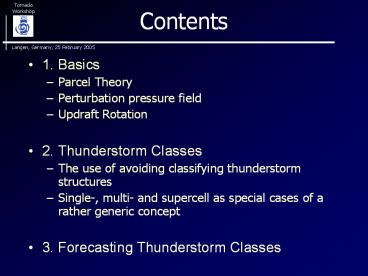Contents - PowerPoint PPT Presentation
Title:
Contents
Description:
Parcel Theory. Perturbation pressure field. Updraft Rotation. 2. ... Basic Parcel Theory. Boussinesq ... develop where moist parcels are lifted to their ... – PowerPoint PPT presentation
Number of Views:40
Avg rating:3.0/5.0
Title: Contents
1
Contents
- 1. Basics
- Parcel Theory
- Perturbation pressure field
- Updraft Rotation
- 2. Thunderstorm Classes
- The use of avoiding classifying thunderstorm
structures - Single-, multi- and supercell as special cases of
a rather generic concept - 3. Forecasting Thunderstorm Classes
2
1.1 Basic Parcel Theory
- Boussinesq approximation
where
Non-hydrostatic pressure gradient force
neglected, and only the Archimedian buoyancy
force considered
CAPE Convective Available Potential
Energy
3
1.2 Skew T-log p diagram
- The green area is proportional to CAPE
- Convective initiation in Parcel Theory
A convective cell is initiated if a moist parcel
is lifted above its LFC.
Source NWS Norman
4
1.3.1 Updraft Rotation
Linearized vorticity equation
The tilting of ambient vorticity
5
1.3.2 Updraft Rotation
Storm-Relative Helicity
6
1.4 Pressure Perturbations
... retaining the perturbation-pressure terms in
the vertical momentum equation ...
The perturbation pressure field p can be found
by solving this equation
Rotation (Spin)
Gradient of Buoyancy
Deformation (Splat)
Forcing related to
7
2.1.1 Classification
- Nature is continuous, any classification scheme
naturally arbitrary - There are many structures that do not readily fit
into a tight classification scheme - Too strong mental adherance to the archetypal
structures may limit ones ability to deal with a
given (non-archetypal) situation - Goal should thus be Use physical concept which
describes all convective structures, and consider
certain classes merely as special cases in the
continuous spectrum
8
2.1.2 Classification
- Possible approach to avoid classification
- Convective cells develop where moist parcels are
lifted to their LFCs - Strength of the (mainly) vertical accelerations
governed by the thermal buoyancy and perturbation
pressure gradient forces - Rotational characteristics of the cells are
determined by the nature of the vorticity
ingested by the updraft - All contributions interact with each other!
9
2.2 Archetypes
- Single-cell thunderstorm
- Isolated supercell thunderstorm
- Multicell thunderstorm
- Weakly organized clusters
- Long-lived, well organized (e.g. squall lines
containing supercells and bow echoes)
10
2.3 Single Cell Thunderstorm
- Localized low-level forcing (in terms of
space/time) - Weak/no wind shear (minimal dynamical
contribution to p) - Weak/no vorticity in the thunderstorm inflow
Source Skywarn
11
2.4.1 Isolated Supercell
- Low-level forcing Localized in space (moving
with the storm), persistent in time - Large contributions to dynamical p
(wind-shear/updraft interaction, rotation) - Large helicity in the inflow (updraft rotation)
A supercell is characterized by the presence of a
deep, persistent mesocyclone.
12
2.4.2 Isolated Supercell
(c) C.A.D. 3.0
13
2.5.1 Multicell Thunderstorm
- Low-level forcing Spatially extensive,
persistent - Strong contributions to p (vertical wind shear,
cold pool) - Vorticity in the inflow (likely generated along
the cold pool), book-end vortices
14
2.5.2 Multicell Thunderstorm
(c) R. Houze, 1993, taken from www.mcwar.com
15
2.6 Upshear Tilt of an MCS
- Perturbation pressure gradient forces cause
convective updrafts to tilt upshear
16
2.7 Bow Echo
Source BAMEX
17
3. Forecasting Thunderstorm Types
- Results based on idealized (numerical) models
concerning detailed shape of the
shear/thermodynamic profiles can seldom be
literally translated into the real world - Shear (and thermodynamic) profiles appear to vary
substantially in space and time, available data
unlikely to be representative for the environment
of a given storm - Often, several storm structures occur at a time,
or storms morph from one type into another during
the their life time
18
3.2.1 Classical Environments
Subjective SFC analysis Berliner Wetterkarte 12Z
De Bilt
June 18th, 2002
19
3.2.2 Classical Environments
500 hPa analysis Berliner Wetterkarte 00Z
June 18th, 2002
20
3.2.3 Classical Environments
21
3.2.4 Classical Environments
(c) D. Kiese, M. Hubrig, S. Lueke
22
3.3.1 Classical Environments
23
3.3.2 Classical Environments
(c) W. Stieglmair
24
3.3.3 Classical Environments
25
4. Conclusions
- Thunderstorm structure is determinded by
- Morphology of the low-level forcing
- Thermodynamic profiles
- Kinematic profiles
- While severe thunderstorm threat can be
forecasted reasonably well, exact forecasts of
dominant cell structure often very difficult - Supercells may occur whenever convection develops
in strongly sheared environment
(model-/sounding-derived SRH not necessarily
high) - A slight chance of mesocyclones exists any time
convection is underway (i.e., one should never be
surprised to see one on radar, even though all
available data might not have suggested that
supercells would be possible)
26
Thank you for your attention!
Questions? Dahl_at_estofex.org































